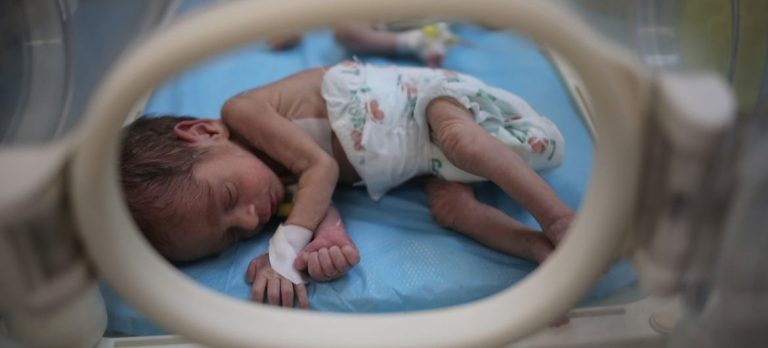
On March 5, 2024, UNICEF and partners delivered 23 incubators to hospitals in Rafah, south of Gaza Strip. Photo: © UNICEF/Eyad El Baba.

Six months after the full-scale invasion of Gaza, 30,000 Palestinians are dead, dozens of children have died of hunger and more than half a million Gazans face starvation. As Israel continues to bomb the occupied territory and restrict the entry of lifesaving goods, the U.N. is scrambling to respond. The U.N. agency for Palestine, UNRWA, reports that a 50 per cent reduction of aid deliveries into Gaza stems from a lack of political will and security assurances from Israeli military operations amid the collapse of civil order. As the crisis escalates, media reports show some nations bypassing Israeli restrictions by airdropping food bundles, and the United States is planning to build a temporary port in Gaza to guarantee aid deliveries. Photo: © UNRWA.

Two-year-old Leen gets her middle-upper-arm-circumference (MUAC) measured, indicating severe acute malnutrition and drastic weight loss and muscle atrophy. The U.N. children’s agency (UNICEF) intervened, and Leen was transferred to Al Awda Hospital for treatment and specialized care in mid-February. Photo: © UNICEF/Eyad El Baba.

A World Health Organization (WHO) team visited the Nasser Medical Complex in Khan Younis in southern Gaza to deliver emergency medical supplies and trauma kits in January. Photo © WHO.

“Children who survived bombardment may not survive a famine,” said WHO’s chief Tedros Adhanom Ghebreyesus, reporting that one in six youngsters in Gaza is currently dangerously malnourished. Photo: © UNRWA/Hussein Owda.

Due to ongoing aid restrictions, newborns are extremely vulnerable to malnutrition, as their mothers do not consume enough food to be able to breastfeed their infants. At Al-Helal Al-Emirate Maternity Hospital in Rafah, 77 infants share 20 incubators. Photo © UNFPA Palestine/Bisan Ouda.

Many children in Gaza are showing signs of severe acute malnutrition and drastic weight loss, according to UNICEF. Three-year-old Akram visited a malnutrition screening tent in Rafah in southern Gaza in mid-February. Photo: © UNICEF/Eyad El Baba.

U.N. agencies and the Palestinian Red Crescent Society deployed emergency missions to hospitals in Gaza in late February to assess conditions and deliver lifesaving aid and medical supplies. Photo: © WHO/Christopher Black

The U.N. World Food Programme (WFP) was forced to pause lifesaving aid deliveries to northern Gaza on 20 February due to a lack of security. A WFP 14-truck convoy tried to deliver aid on 5 March, but was turned away by the Israeli Defence Forces (IDF). Photo: © WFP/Ali Jadallah

At least 20 children have succumbed to starvation in the besieged and bombarded enclave, including most recently a 14-day-old baby, according to media reports. Photo: © UNRWA.

U.N. agencies managed to deliver 9,500 litres of fuel and essential medical supplies to Al-Adwa Hospital in northern Gaza. Photo: © WHO.

The volume of aid getting into Gaza is far from enough to meet the growing needs of a population that has faced a total siege since October, as Israel cut off electricity and water while severely restricting aid from entering the enclave, according to the UN humanitarian aid office, OCHA. Photo: © UNRWA.

An UNRWA employee gathers information from a mother holding her six-day-old baby, who was born at the Al Amal Hospital in Khan Younis, where a joint UN mission visited in February. Photo: © WHO/Christopher Black.

Working with six partners, including the Friends Kitchen, WFP is helping to provide meals for families in Gaza, where 85 per cent of the enclave’s 2.2 million population has been displaced. Photo: © WFP/Mostafa Ghroz.